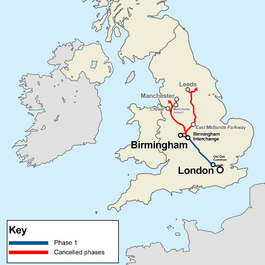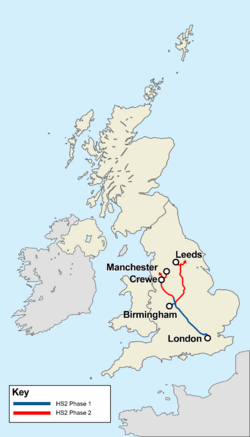High Speed 2 facts for kids
Quick facts for kids High Speed 2 |
|
|---|---|
 |
|
| Overview | |
| Status |
|
| Locale | |
| Termini | London Euston
|
| Stations |
|
| Service | |
| Type | High-speed railway |
| System | National Rail |
| Technical | |
| Line length |
|
| Number of tracks | Double track |
| Track gauge | 1,435 mm (4 ft 8 1⁄2 in) standard gauge |
| Loading gauge | UIC GC |
| Electrification | Template:25 kV 50 Hz AC overhead line |
| Operating speed | 360 km/h (225 mph) maximum, 330 km/h (205 mph) routinely |
High Speed 2 (HS2) is a planned high-speed railway line and network of passenger train services in England. It will consist of a new railway line between the West Midlands and London, with a branch to Birmingham, and a network of train services that will use the new line and existing conventional track to reach their destinations in the Midlands, Northern England, and Scotland. HS2 will be Britain's second purpose-built high-speed line, the first being High Speed 1, which connects London to the Channel Tunnel. The majority of the project is planned to be completed between 2029 and 2033.
The new line will run between London Euston railway station and Fradley in southern Staffordshire, with stations at Old Oak Common, in northwest London, and Birmingham Interchange, near Solihull. There will be spurs to a planned station in central Birmingham and a junction with the West Coast Main Line (WCML) at Handsacre, near Lichfield. The rolling stock will run at a maximum speed of 360 km/h (225 mph) and will operate on both HS2 track and existing conventional track.
The proposed network has been reduced substantially since it was announced in 2013. The line would originally have formed a 'Y' shape, branching north of Birmingham Interchange. The western section would run to Crewe and then form two branches, one terminating in Manchester and the other connecting to the WCML at Golborne, south of Wigan. The eastern section would run through the East Midlands and connect to the Midland Main Line north of Derby, then continue to Leeds; it would then form two branches, one terminating in central Leeds and the other connecting to the East Coast Main Line near York. In November 2021, the eastern branch was truncated and redirected to East Midlands Parkway railway station, south of Nottingham. In June 2022, the Golborne link to the WCML was cancelled. In October 2023, the western branch, from Fradley to Manchester, and the remainder of the eastern branch were cancelled. In March 2023, work was paused between Old Oak Common and Euston, but the line is still expected to terminate at the latter. A 2019 review of the project as then planned estimated that it would cost up to £87 billion; however, this is estimated to have risen to approximately £100 billion in 2023.
The project has both supporters and opponents. Supporters of the project believe that the additional capacity and reliability provided by HS2 will accommodate passenger numbers rising to pre-COVID-19 levels while driving a further modal shift to rail. Opponents believe that the project is neither environmentally nor financially sustainable.
History
In 2003, high-speed rail arrived in the United Kingdom with the opening of the first part of High Speed 1 (HS1), then known as the 67-mile-long (108 km) Channel Tunnel Rail Link between London and the Channel Tunnel. In 2009, the Department for Transport (DfT) under the Labour government proposed to assess the case for a second high-speed line, which was to be developed by a new company, High Speed Two Limited (HS2 Ltd).
In December 2010, following a review by the Conservative–Liberal Democrat coalition, a route was proposed, subject to public consultation, based on a Y-shaped route from London to Birmingham with branches to Leeds and Manchester, as originally put forward by the previous Labour government, with alterations designed to minimise the visual, noise, and other environmental impacts of the line.
In January 2012, the Secretary of State for Transport announced that HS2 would go ahead in two phases and the legislative process would be achieved through two hybrid bills. The High Speed Rail (London - West Midlands) Act 2017, authorising the construction of Phase 1, passed both Houses of Parliament and received Royal Assent in February 2017. A Phase 2a High Speed Rail (West Midlands–Crewe) bill, seeking the power to construct Phase 2 as far as Crewe and to make decisions on the remainder of the Phase 2b route, was introduced in July 2017. Phase 2a received royal assent in February 2021.
One of the stated aims of the project is to increase the capacity of the railway network. It is envisaged that the introduction of HS2 will free up space on existing railway lines by removing a number of express services, thus allowing additional local train services to run and enabling the network to handle increased passenger numbers. Network Rail considers that constructing a new high-speed railway will be more cost-effective and less disruptive than upgrading the existing conventional rail network. The DfT has forecast that improved connectivity will have a positive economic impact, and that favourable journey times and ample capacity will generate a modal shift from air and road to rail.
Oakervee Review
On 21 August 2019, the DfT ordered an independent review of the project. The review was chaired by Douglas Oakervee, a British civil engineer, who had been HS2's non-executive chairman for nearly two years. The review was published by the DfT on 11 February 2020, alongside a statement from the Prime Minister confirming that HS2 would go ahead in full, with reservations. Oakervee's conclusions were that the original rationale for High Speed 2—to provide capacity and reliability on the rail network—was still valid, and that no "shovel-ready" interventions existed that could be deployed within the timeframe of the project. As a consequence, Oakervee recommended that the project go ahead as planned, subject to a series of further recommendations. After concluding that the project should proceed, the review recommended a further review of HS2 that would be undertaken by the Infrastructure and Projects Authority and would concentrate on reducing costs and over-specification.
On 15 April 2020, formal approval was given to construction companies to start work on the project.
In July 2023 the Infrastructure Projects Authority annual report gave Phases 1 and 2A project a "red" rating, meaning "Successful delivery of the project appears to be unachievable. There are major issues with project definition, schedule, budget, quality and/or benefits delivery, which at this stage do not appear to be manageable or resolvable. The project may need re-scoping and/or its overall viability reassessed." Measures such as reducing the speed of trains and their frequency, and general cost-cutting predominately affecting Phase 2b, would be assessed.
Integrated Rail Plan
On 18 November 2021, the government's delayed Integrated Rail Plan was published. The plan significantly affected parts of the HS2 programme, including curtailing much of the eastern leg.
Under the original proposal for the eastern leg, the high-speed line would have been built with a link to the East Coast Main Line south of York for trains to continue to Newcastle. A branch would take trains into Leeds. There would also have been a branch to the Midland Main Line north of Derby for trains to continue to Sheffield. The original scheme also included a through station at Toton, between Nottingham and Derby. The HS2 eastern section was largely eliminated, leaving a branch from Coleshill near Birmingham to East Midlands Parkway station, just south of Nottingham and Derby, where the HS2 track would end, with trains continuing north onto the Midland Main Line to serve the existing stations at Nottingham, Derby, Chesterfield, and Sheffield. HS2 trains would serve the centres of Nottingham and Derby, unlike in the previous proposal.
Upgrades to the East Coast Main Line have been proposed to offer time improvements on the London to Leeds and Newcastle routes. Services from Birmingham to Leeds and Newcastle are still planned to use the remaining section of the HS2 eastern leg. The London to Sheffield service will remain on the Midland Main Line, to equal the proposed original HS2 journey times. The integrated Rail Plan proposed a study to determine the best way for HS2 trains to reach Leeds.
In June 2022, the Golborne spur was removed from the Crewe-to-Manchester Parliamentary Bill. Without this link, trains to Scotland would join the existing West Coast Main Line further south at Crewe, instead of south of Wigan. The Department of Transport stated that the government was considering the recommendations of the Union Connectivity Review, which gave alternatives such as a more northerly HS2 connection to the West Coast Main Line than Golborne and upgrades to the West Coast Main Line from Crewe to Preston. The Department of Transport will publish its response subject to the funding allocated in the integrated Rail Plan.
Cancellation of Phase 2
On 4 October 2023 the Prime Minister Rishi Sunak announced that Phase 2 would be abandoned and that responsibility for the Euston connection would be removed from HS2 Ltd.


